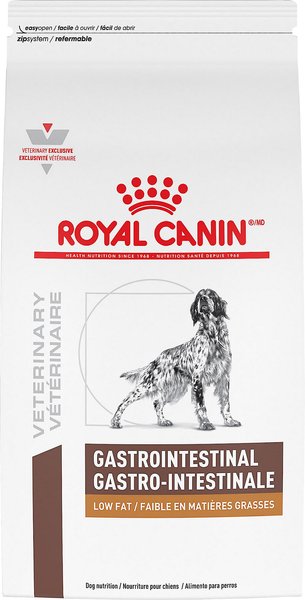
DogFoodAdvisor is reader supported See how
All reviews are 100% impartial but if you buy using links on this page, we may earn a referral fee.
Our Verdict
Royal Canin Veterinary Diets Gastrointestinal Dog Food is not rated due to its intentional therapeutic design.
The Royal Canin Veterinary Diets Gastrointestinal product line includes six dry dog foods, each designed to help in the treatment of gastrointestinal disorders.
The table below shows each recipe in this range including our rating and the AAFCO nutrient profile: Growth (puppy), Maintenance (adult), All Life Stages, Supplemental or Unspecified.
| Product line | Rating | AAFCO |
|---|---|---|
| Royal Canin Veterinary Diet Gastrointestinal Puppy | Not Rated | G |
| Royal Canin Veterinary Diet Gastrointestinal Low Fat Small Dog | Not Rated | M |
| Royal Canin Veterinary Diet Gastrointestinal | Not Rated | M |
| Royal Canin Veterinary Diet Gastrointestinal Moderate Calorie | Not Rated | M |
| Royal Canin Veterinary Diet Gastrointestinal Low Fat | Not Rated | M |
| Royal Canin Veterinary Diet Gastrointestinal High Fiber | Not Rated | M |
Recipe and Label Analysis
Royal Canin Veterinary Diet Gastrointestinal Low Fat was selected to represent the other products in the line for detailed recipe and nutrient analysis.
Royal Canin Veterinary Diet Gastrointestinal Low Fat
Estimated Dry Matter Nutrient Content
Protein
Fat
CarbsCarbohydrates
Brewers rice, chicken by-product meal, barley, natural flavors, pork digest, pea fiber, dried plain beet pulp, chicken fat, monocalcium phosphate, salt, potassium chloride, calcium carbonate, powdered psyllium seed husk, sodium aluminosilicate, fish oil, fructooligosaccharides, choline chloride, vitamins[dl-alpha tocopherol acetate (source of vitamin E), l-ascorbyl-2-polyphosphate (source of vitamin C), biotin, D-calcium pantothenate, vitamin A acetate, riboflavin supplement, niacin supplement, vitamin B12 supplement, pyridoxine hydrochloride (vitamin B6), thiamine mononitrate (vitamin B1), vitamin d3 supplement, folic acid], rosemary extract, preserved with mixed tocopherols and citric acid, hydrolyzed yeast, dl-methionine, marigold extract (tagetes erecta l.), trace minerals[zinc proteinate, zinc oxide, ferrous sulfate, manganese proteinate, manganous oxide, copper sulfate, sodium selenite, calcium iodate, copper proteinate], taurine
Fiber (estimated dry matter content) = 4.8%
Red denotes any controversial items
| Estimated Nutrient Content | |||
|---|---|---|---|
| Method | Protein | Fat | Carbs |
| Guaranteed Analysis | 20% | 5% | NA |
| Dry Matter Basis | 22% | 6% | 64% |
| Calorie Weighted Basis | 22% | 14% | 64% |
Ingredients Analysis
The first ingredient in this dog food is brewers rice. Brewers rice is a cereal grain by-product consisting of the small fragments left over after milling whole rice. Aside from the caloric energy it contains, this item is of only modest nutritional value to a dog.
The second ingredient is chicken by-product meal, a dry rendered product of slaughterhouse waste. It’s made from what’s left of a slaughtered chicken after all the choice cuts have been removed.
On the brighter side, by-product meals are meat concentrates and contain nearly 300% more protein than fresh chicken.
The quality of this ingredient can vary, depending on the caliber of the raw materials obtained by the manufacturer.
The third ingredient is barley. Barley is a starchy carbohydrate supplying fiber and other healthy nutrients. However, aside from its energy content, this cereal grain is of only modest nutritional value to a dog.
The fourth ingredient is natural flavours which doesn’t give us much information about the particular ingredients included in this cat food for flavoring purposes.
We’re pleased that the flavorings used are natural, but more details are required to give any further information about these natural flavouring ingredients. Flavorings are used to make the foods more appealing and tasty for our cats.
After the natural flavor, we find pork digest which is a chemically hydrolyzed mixture of animal by-products that is typically sprayed onto the surface of a dry kibble to improve its taste.
The sixth ingredient is pea fiber a mixture of both soluble and insoluble dietary fiber derived from pea hulls. Aside from the usual benefits of fibre, this agricultural by-product provides no other nutritional value to a dog.
The seventh ingredient is beet pulp. Beet pulp is a controversial ingredient, a high fiber by-product of sugar beet processing.
Some denounce beet pulp as an inexpensive filler while others cite its outstanding intestinal health and blood sugar benefits.
We only call your attention here to the controversy and believe the inclusion of beet pulp in reasonable amounts in most dog foods is entirely acceptable.
The eighth ingredient is chicken fat. This item is obtained from rendering chicken, a process similar to making soup in which the fat itself is skimmed from the surface of the liquid.
Chicken fat is high in linoleic acid, an omega-6 fatty acid essential for life. Although it doesn’t sound very appetizing, chicken fat is actually a quality ingredient.
From here, the list goes on to include a number of other items.
But to be realistic, ingredients located this far down the list (other than nutritional supplements) are not likely to affect the overall rating of this product.
With five notable exceptions…
First, fish oil is naturally rich in the prized EPA and DHA type of omega-3 fatty acids. These two high quality fats boast the highest bio-availability to dogs and humans.
Depending on its level of freshness and purity, fish oil should be considered a commendable addition.
Next, this recipe contains fructooligosaccharide, an alternative sweetener1 probably used here as a prebiotic. Prebiotics function to support the growth of healthy bacteria in the large intestine.
In addition, we note the use of taurine, an important amino acid associated with the healthy function of heart muscle. Although taurine is not typically considered essential in canines, some dogs have been shown to be deficient in this critical nutrient.
Since taurine deficiency appears to be more common in pets consuming grain-free diets, we view its presence in this recipe as a positive addition.
This recipe also contains sodium selenite, a controversial form of the mineral selenium. Sodium selenite appears to be nutritionally inferior to the more natural source of selenium found in selenium yeast.
And lastly, this food includes chelated minerals, minerals that have been chemically attached to protein. This makes them easier to absorb. Chelated minerals are usually found in better dog foods.
Nutrient Analysis
Although this is a prescription product, our review has nothing to do with the accuracy of claims made by the manufacturer as to the product’s ability to treat or cure a specific health condition.
So, to find out whether or not this dog food is appropriate for your particular pet, it’s important to consult your veterinarian.
With that understanding…
Based on its ingredients alone, Royal Canin Veterinary Diets Gastrointestinal looks like an average dry dog food.
The dashboard displays a dry matter protein reading of 22%, a fat level of 6% and estimated carbohydrates of about 64%.
As a group, the brand features an average protein content of 24.7% and a mean fat level of 13.3%. Together, these figures suggest a carbohydrate content of 54.1% for the overall product line.
And a fat-to-protein ratio of about 52%.
Which means this product contains…
Below-average protein. Below-average fat. And above-average carbs when compared to a typical dry dog food.
When you consider the protein-boosting effect of the corn gluten meal and dried yeast (contained in some recipes), this looks like the profile of a dry product containing a moderate amount of meat.
Royal Canin Dog Food Recall History
The following automated list (if present) includes all dog food recalls related to Royal Canin through December 2025.
No recalls noted.
You can view a complete list of all dog food recalls since 2009 here.
Our Rating of Royal Canin Veterinary Diets Gastrointestinal Dog Food
Royal Canin Veterinary Diets Gastrointestinal is a grain-inclusive dry dog food using a moderate amount of named by-product meal as its dominant source of animal protein.
Compare Royal Canin Dog Food
How does Royal Canin compare with The Dog Food Advisor's most recommended brands?
A Final Word
The Dog Food Advisor does not accept money, gifts, samples or other incentives in exchange for special consideration in preparing our reviews.
However, we do receive a referral fee from online retailers (like Chewy or Amazon) and from sellers of perishable pet food when readers click over to their websites from ours. This helps cover the cost of operation of our free blog. Thanks for your support.
For more information, please visit our Disclaimer and Disclosure page.







